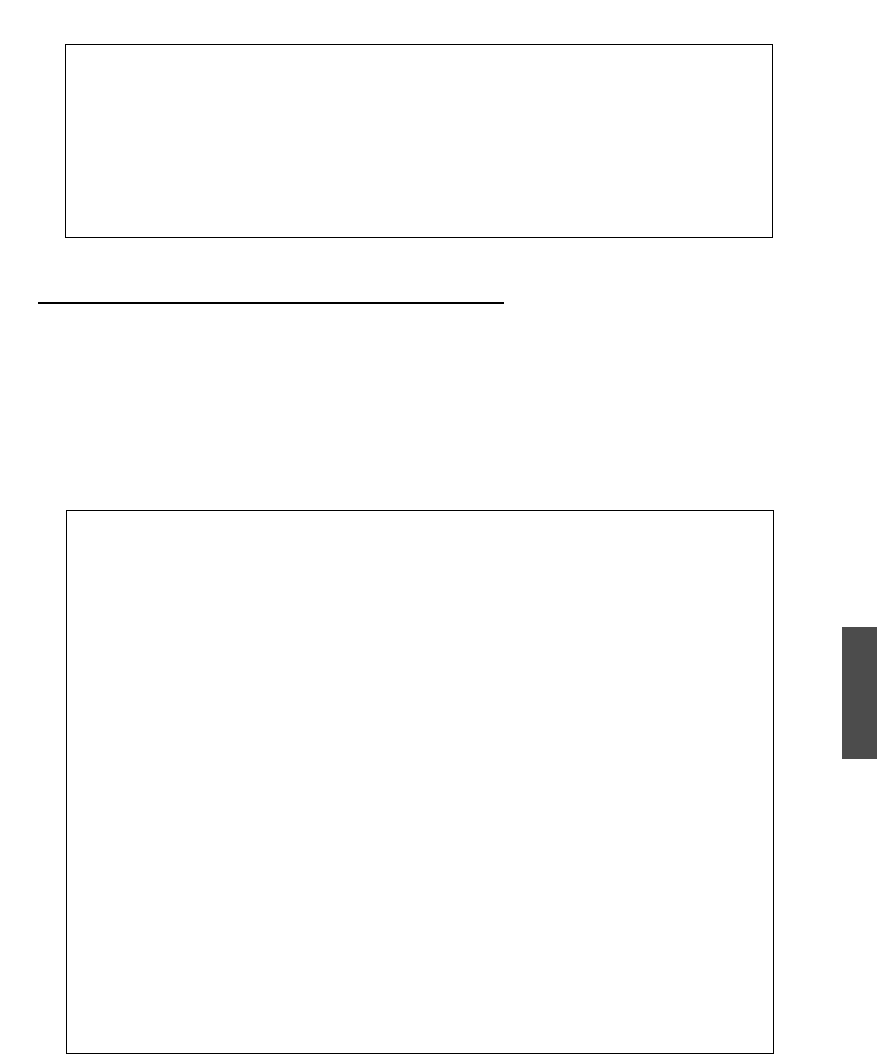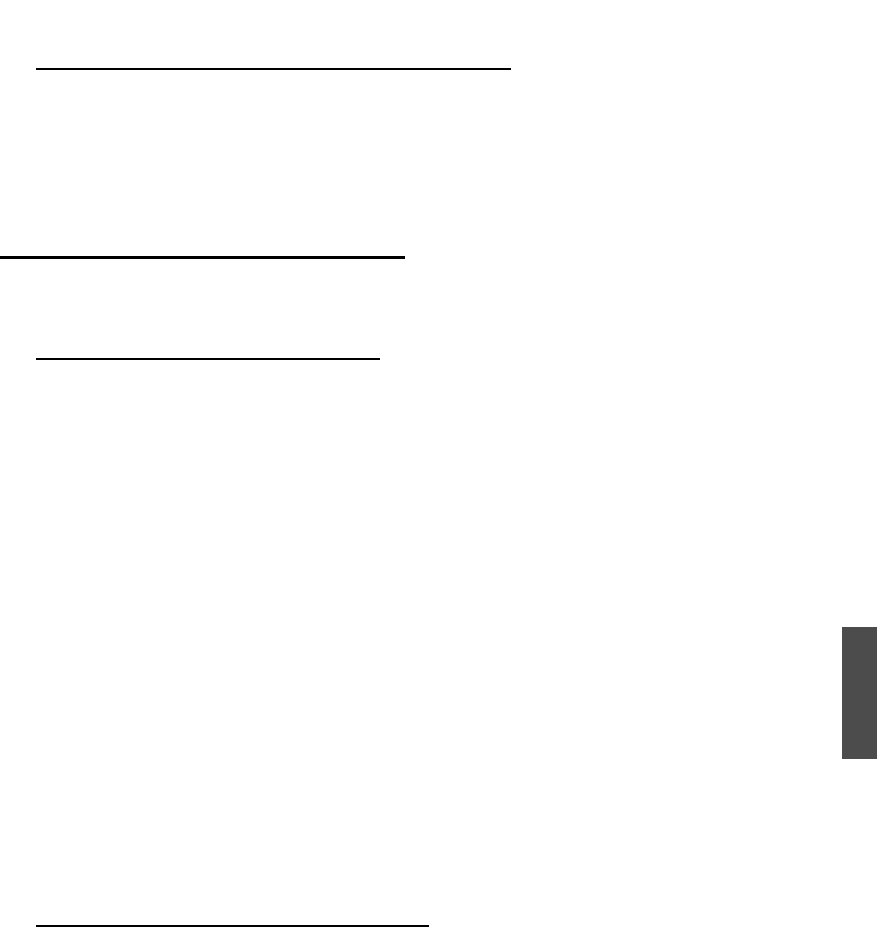Richard A. Caralli, Julia H. Allen, David W. White. CERT Resilience Management Model
Подождите немного. Документ загружается.


2. Fund the process.
Refer to the Financial Resource Management process area for information about
budgeting for, funding, and accounting for human resource management.
3. Provide necessary tools, techniques, and methods to perform the process.
Elaboration:
Human Resource Management 437
HRM
These are examples of tools, techniques, and methods to support the human
resource management process:
• a performance management system that supports establishing performance goals
and objectives and evaluating performance against them
• job description templates that reflect standard resilience obligations, roles and
responsibilities, required skills, and specific job requirements (e.g., certifications)
• methods, techniques, and tools for identifying, documenting, maintaining, and
validating the resilience skills of current human resources as a skills inventory
• tools for performing skill gap analysis (between baseline competencies and
current skill sets)
• training plan templates for specific roles and responsibilities
• methods, techniques, and tools necessary to perform background verification
checks
• methods, techniques, and tools to capture, securely store, and ensure authorized
access to sensitive verification data
• templates for employment agreements, terms and conditions, confidentiality
agreements, and non-compete agreements
• templates for asset inventory checklist capture and sign-off
• disciplinary process checklists
• exit interview, termination, and layoff checklists
HRM:GG2.GP4 ASSIGN RESPONSIBILITY
Assign responsibility and authority for performing the human resource management
process, developing the work products, and providing the services of the process.
Elaboration:
Of paramount importance in assigning responsibility for the human resource
management process is establishing job responsibilities and assigned roles for
all operational resilience management system activities. Staff are responsible
for establishing resilience requirements for all assets and services, ensuring
these requirements are met by asset/service owners and custodians, and iden-
tifying and remediating gaps where requirements are not being met. Staff also
have the responsibility to develop resilience-specific performance goals and
objectives and to measure and assess performance against these goals
and objectives.

Subpractices
1. Assign responsibility and authority for performing the process.
Elaboration:
Responsibility and authority may extend not only to staff inside the organization
but to those with whom the organization has a contractual (custodial) agreement
for managing human resources (by contracting staff or supplementing staff
through outsourcing).
2. Assign responsibility and authority for performing the specific tasks of the
process.
Elaboration:
438 PART THREE CERT-RMM PROCESS AREAS
Responsibility and authority for performing human resource management tasks can
be formalized by
• defining roles and responsibilities in the process plan to include roles responsible
for workforce development, performance management, and background
verification
• including process tasks and responsibility for these tasks in specific job descriptions
• developing policy requiring
– organizational unit managers, line of business managers, project managers, and
asset and service owners and custodians to participate in and derive benefit
from the process for assets and services under their ownership or custodianship
– staff to take personal responsibility for acquiring the necessary skill sets to
fulfill their job description and roles in sustaining operational resilience
– compliance with resilience directives
• including process tasks in staff performance management goals and objectives,
with requisite measurement of progress against these goals
• developing and implementing contractual instruments (including service level
agreements) with external entities to establish responsibility and authority for
performing process tasks on outsourced functions
• including process tasks in measuring performance of external entities against
contractual instruments
Refer to the External Dependencies Management process area for additional details
about managing relationships with external entities.
3. Confirm that people assigned with responsibility and authority understand it and
are willing and able to accept it.

HRM:GG2.GP5 TRAIN PEOPLE
Train the people performing or supp orting the human resource management process as
needed.
Elaboration:
The basis for determining training needs for operational resilience manage-
ment derives from having a comprehensive inventory of current skill sets,
establishing a skill set baseline, identifying required skill sets, and measuring
and addressing skill set deficiencies.
Refer to the Organizational Training and Awareness process area for more information
about training the people performing or supporting the process.
Subpractices
1. Identify process skill needs.
Elaboration:
Human Resource Management 439
HRM
These are examples of skills required in the human resource management process:
• knowledge of tools, techniques, and methods necessary to perform process tasks,
including those identified in HRM:GG2.GP3 subpractice 3
• knowledge necessary to elicit baseline competencies from the organization’s
resilience program and plan as well as from resilience job descriptions
• knowledge necessary to develop, populate, and maintain a skills inventory
• knowledge necessary to compare baseline competencies with current skills and
identify and prioritize key skill gaps and deficiencies requiring action
• knowledge necessary to identify operational risks emerging from the process that
should be referred to the risk management process for disposition
• knowledge necessary to establish and conduct verification programs and
procedures in support of candidate screening
• knowledge necessary to establish the appropriate terms and conditions of
employment that reflect the resilience obligations of the job as well as applicable
laws and regulations
• knowledge necessary to evaluate staff performance against resilience goals and
objectives, identify improvements, and take corrective actions
• knowledge necessary to investigate resilience and security breaches and take
necessary disciplinary action
• knowledge necessary to manage sustaining and reassigning resilience roles and
responsibilities regardless of cause or initiating event
2. Identify process skill gaps based on available resources and their current skill
levels.
3. Identify training opportunities to address skill gaps.

Elaboration:
440 PART THREE CERT-RMM PROCESS AREAS
These are examples of training topics:
• skill deficiencies of existing staff (The development of training plans is addressed
in the Organizational Training and Awareness process area.)
• general awareness training on the importance of operational resilience in ensur-
ing that all categories of assets (people, information, technology, and facilities) are
protected and sustained
• training for human resources practitioners (such as placement specialists, com-
pensation analysts, and benefits managers) who do not have specific experience
in resilience job roles or skills
• working with external entities that have responsibility for process activities
• using process methods, tools, and techniques, including those identified in
HRM:GG2.GP3 subpractice 3
4. Provide training and review the training needs as necessary.
HRM:GG2.GP6 MANAGE WORK PRODUCT CONFIGURATIONS
Place designated work products of the human resource management process under appro-
priate levels of control.
Elaboration:
All work products related to human resources documents, such as personal infor-
mation about pre-employment verification data and performance evaluations,
should be placed under control, with appropriate levels of access privileges.
These are examples of human resource management work products placed under
control:
• baseline competencies
• job descriptions
• skills inventory, including skill gaps and deficiencies
• training plans
• job requisitions
• outsourcing agreements
• verification procedures and guidelines
• screening criteria
• employment agreements, including terms and conditions of employment
• resilience goals and objectives
• performance evaluations

• disciplinary process investigation reports and supporting documentation
• confidentiality and non-compete agreements
• notes from exit interviews
• signed-off versions of asset inventories for all terminated staff
• process plan
• policies and procedures
• contracts with external entities
Human Resource Management 441
HRM
HRM:GG2.GP7 IDENTIFY AND INVOLVE RELEVANT STAKEHOLDERS
Identify and involve the relevant stakeholders of the human resource management process
as planned.
Subpractices
1. Identify process stakeholders and their appropriate involvement.
Elaboration:
These are examples of stakeholders of the human resource management process:
• staff involved in identifying resilience baseline competencies and skills
• owners and custodians of information, technology, and facility assets to which
people need access
• staff responsible for
– managing operational risks that involve people
– establishing, implementing, and maintaining an internal control system for
human resources
– developing, testing, implementing, and executing service continuity plans
involving people
– developing, implementing, or managing organizational training, skill develop-
ment, and knowledge transfer
• external entities such as employment recruiters, temporary placement agencies,
and contractors that provide human resources services
• staff in other organizational support functions such as payroll or general services
administration
• human resources staff
• legal counsel
• public authorities such as law enforcement that may have to be involved in
disciplinary actions
• internal and external auditors

Stakeholders are involved in various tasks in the human resource management
process, such as
• planning for human resource recruiting and placement
• planning for compensation, benefits, and skills analysis
• establishing baseline competencies required to meet resilience requirements
• creating human resource job role profiles and skills inventory
• associating human resources with services and analyzing service dependencies
• establishing, implementing, and managing human resource access controls
• developing service continuity and succession plans for job roles
• managing operational risks from people
• assessing the adequacy of internal controls and separation of duties
• training and development of people
• managing external dependencies on people
• overseeing industrial relations, collective bargaining, and grievance procedures
for human resources
• providing feedback to the organization on resilience job roles and skills
• reviewing and appraising the effectiveness of process activities
• resolving issues in the process
442 PART THREE CERT-RMM PROCESS AREAS
2. Communicate the list of stakeholders to planners and those responsible for
process performance.
3. Involve relevant stakeholders in the process as planned.
HRM:GG2.GP8 MONITOR AND CONTROL THE PROCESS
Monitor and control the human resource management process against the plan for perform-
ing the process and take appropriate corrective action.
Elaboration:
Refer to the Monitoring process area for more information about the collection, organiza-
tion, and distribution of data that may be useful for monitoring and controlling processes.
Refer to the Measurement and Analysis process area for more information about establish-
ing process metrics and measurement.
Refer to the Enterprise Focus process area for more information about providing process
information to managers, identifying issues, and determining appropriate corrective
actions.
Subpractices
1. Measure actual performance against the plan for performing the process.
2. Review accomplishments and results of the process against the plan for
performing the process.

Elaboration:
Human Resource Management 443
HRM
These are examples of metrics for the human resource management process:
• percentage of human resources who have job descriptions
• percentage of job descriptions for which resilience goals and objectives are
included
• number and percentage of skill deficiencies for vital staff
• cost, schedule, and effort required to address skill gaps
• percentage of human resources that have met the pre-employment verification
criteria
• number of jobs for which skills are defined
• schedule for collecting and reviewing measures of policy compliance
• number of resilience awareness and training courses delivered versus number of
planned courses
• number of changes made to the human resources skills inventory during a stated
period
• number and type of performance reviews performed
• statistics for staff availability to conduct service continuity planned tests
• timeliness of completing scheduled human resource performance review
activities
• percentage of confidentiality and non-compete agreements executed for people
in sensitive positions
• number of infractions referred to the incident management process
• number of infractions requiring coordination with public authorities
• number of skill gap and other process risks referred to the risk management
process; number of risks where corrective action is still pending (by risk rank)
• level of adherence to process policies including clean desk and screen policies;
number of policy violations including access control policies; number of policy
exceptions requested and number approved
• number of violations of resilience policies subject to disciplinary action
• number of process activities that are on track per plan
• rate of change of resource needs to support the process
• rate of change of costs to support the process
3. Review activities, status, and results of the process with the immediate level of
managers responsible for the process and identify issues.
Elaboration:
Periodic reviews of the human resource management process are needed to ensure
that
• recruiting and hiring reflect the identified skill gaps that have to be filled
• changes to human resources are accurately communicated, implemented, and doc-
umented. (This is particularly critical when dealing with terminations and layoffs.)

• resilience roles are included in job descriptions
• actions requiring management involvement are elevated in a timely manner
• the performance of process activities is being monitored and regularly reported
• key measures are within acceptable ranges as demonstrated in governance
dashboards or scorecards and financial reports
• administrative, technical, and physical controls are operating as intended
• controls are meeting the stated intent of the resilience requirements
• actions resulting from internal and external audits are being closed in a timely
manner
444 PART THREE CERT-RMM PROCESS AREAS
4. Identify and evaluate the effects of significant deviations from the plan for
performing the process.
5. Identify problems in the plan for performing and executing the process.
6. Take corrective action when requirements and objectives are not being satisfied,
when issues are identified, or when progress differs significantly from the plan
for performing the process.
7. Track cor rective ac tion to closure.
HRM:GG2.GP9 OBJECTIVELY EVALUATE ADHERENCE
Objectively evaluate adherence of the human resource management process against its
process description, standards, and procedures, and address non-compliance.
Elaboration:
These are examples of activities to be reviewed:
• assignment of responsibility, accountability, and authority for process activities
• determination of the adequacy of process reports and reviews in informing deci-
sion makers regarding the performance of operational resilience management
activities and the need to take corrective action, if any
• validation of the organization’s hiring, background check, and other vetting
processes for new and continuing employees as well as external entities
• verification of the internal control system for human resources
These are examples of work products to be reviewed:
• process plan and policies
• disciplinary process reports, particularly for repeat offenders
• layoff and involuntary termination reports
• metrics for the process (Refer to HRM:GG2.GP8 subpractice 2.)
• contracts with external entities

HRM:GG2.GP10 REVIEW STATUS WITH HIGHER-LEVEL MANAGERS
Review the activities, status, and results of the human resource management process with
higher-level managers and resolve issues.
Refer to the Enterprise Focus process area for more information about providing sponsorship
and oversight to the operational resilience management system.
HRM:GG3 INSTITUTIONALIZE A DEFINED PROCESS
Human resource management is institutionalized as a defined process.
HRM:GG3.GP1 ESTABLISH A DEFINED PROCESS
Establish and maintain the description of a defined human resource management process.
Establishing and tailoring process assets, including standard processes, are addressed in the
Organizational Process Definition process area.
Establishing process needs and objectives and selecting, improving, and deploying process
assets, including standard processes, are addressed in the Organizational Process Focus
process area.
Subpractices
1. Select from the organization’s set of standard processes those processes that cover
the human resource management process and best meet the needs of the organi-
zational unit or line of business.
2. Establish the defined process by tailoring the selected processes according to the
organization’s tailoring guidelines.
3. Ensure that the organization’s process objectives are appropriately addressed in
the defined process, and ensure that process governance extends to the tailored
processes.
4. Document the defined process and the records of the tailoring.
5. Revise the description of the defined process as necessary.
HRM:GG3.GP2 COLLECT IMPROVEMENT INFORMATION
Collect human resource management work products, measures, measurement results, and
improvement information derived from planning and performing the process to support
future use and improvement of the organization’s processes and process assets.
Human Resource Management 445
HRM

Elaboration:
446 PART THREE CERT-RMM PROCESS AREAS
These are examples of improvement work products and information:
• the status of human resources with respect to skill currency, skill gaps, and skill
deficiencies
• metrics and measurements of the viability of the process (Refer to HRM:GG2.GP8
subpractice 2.)
• changes and trends in operating conditions, risk conditions, and the risk
environment that affect process results
• lessons learned in post-event review of incidents and disruptions in continuity
• process lessons learned that can be applied to improve operational resilience
management performance
• reports on the effectiveness and weaknesses of controls
• process action plans and strategies that are not being satisfied and the risks
associated with these
• the disposition of process risks that have been referred to the risk management
process
• resilience requirements that are not being satisfied or are being exceeded
Establishing the measurement repository and process asset library is addressed in the
Organizational Process Definition process area. Updating the measurement repository
and process asset library as part of process improvement and deployment is addressed
in the Organizational Process Focus process area.
Subpractices
1. Store process and work product measures in the organization’s measurement
repository.
2. Submit documentation for inclusion in the organization’s process asset library.
3. Document lessons learned from the process for inclusion in the organization’s
process asset library.
4. Propose improvements to the organizational process assets.
